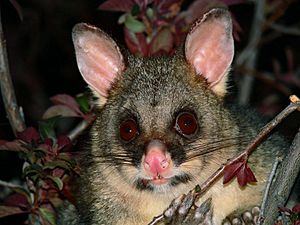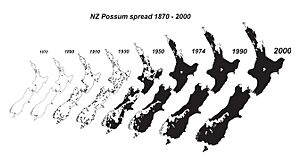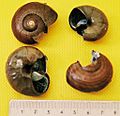Common brushtail possum in New Zealand facts for kids
The common brushtail possum (Trichosurus vulpecula) is a type of possum that originally came from Australia. In New Zealand, it has become a big problem for the environment and farms.
Contents
Why Possums Came to New Zealand
In the 1850s, people from Europe brought common brushtail possums to New Zealand from Australia. They wanted to start a wild population. This was so they could hunt them for food, fur, and other materials.
By the 1980s, the number of possums in New Zealand grew very large. There were about 60 to 70 million of them! Thanks to efforts to control them, by 2009, the population was brought down to around 30 million.
How Possums Harm New Zealand
When possums were brought to New Zealand, it caused problems for the local environment. Possums love to eat certain native plants. They especially enjoy broadleaved trees like the rata.
Eating these plants can hurt the trees and make it harder for native birds to find food. This changes the forest and can even cause the tops of trees to die. Possums also eat the eggs of native birds.
Possums can also spread a sickness called bovine tuberculosis (TB). This disease can affect cows and deer. It is a big problem for New Zealand's dairy, beef, and deer farms.
Controlling Possums

People use different ways to control possums. They use traps to catch them. They also use bait on the ground. In places where other methods are hard to use, they might use a special poison called 1080 from the air.
Using Possum Products
Possum fur is used to make clothing and other items. Trappers and hunters collect the fur. This fur is sometimes sold as 'eco-fur'.
There is also a small business that turns possum meat into dog food. This dog food, called 'Possyum', is even sold to other countries.
Cool Facts About Possums
- In the Māori language, the common brushtail possum is called paihamu.
- Almost half of New Zealand's plant-covered land is under some kind of possum control. That's about 13.3 million hectares!
- Possum hairs are hollow, just like polar bear hairs. This makes their fur very soft and great for keeping warm.
- In some parts of Asia, like Taiwan, Hong Kong, and Malaysia, possum meat is seen as a special food. It is sometimes called "Kiwi bear".
Images for kids




